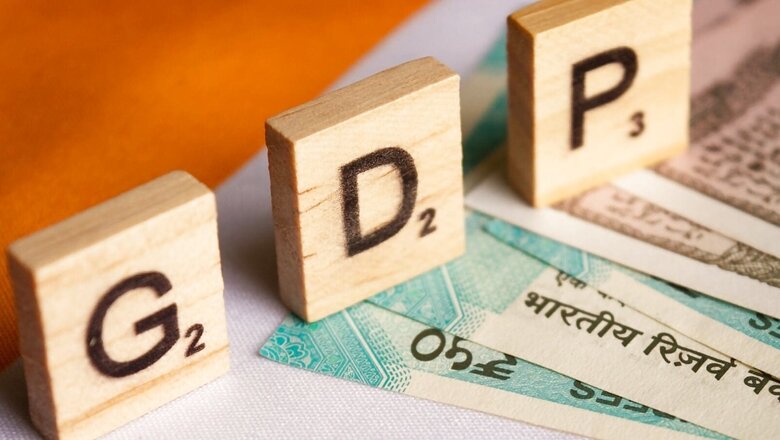
views
India’s gross domestic product (GDP) grew 4.1 per cent in the fourth quarter of the financial year 2021-22. For the full financial year 2021-22, the GDP saw a growth of 8.7 per cent. The economic growth had witnessed a contraction of 6.6 per cent in the previous financial year 2020-21.
The gross domestic product (GDP) had expanded by 2.5 per cent in the corresponding January-March period of 2020-21. The economy had witnessed a growth of 5.4 per cent in the December 2021 quarter.
“Real GDP or gross domestic product (GDP) at constant (2011-12) prices in the year 2021-22 is estimated to attain a level of Rs 147.36 lakh crore, as against the First Revised Estimate of Rs 135.58 lakh crore for the year 2020-21, released on 31.01.2022. The growth in GDP during 2021-22 is estimated at 8.7 per cent as compared to a contraction of 6.6 per cent in 2020-21,” according to an official statement released on Tuesday.
The GDP growth of 8.7 per cent in 2021-22 is significantly better than last year’s 6.6 per cent contraction and points towards a recovery from the pandemic-driven slowdown. However, it is lower than the 8.9 per cent pegged in the second advance estimates (SAE) for 2021-22 released by the National Statistical Office (NSO) in February. The 8.7 per cent growth also falls short of the Reserve Bank of India’s (RBI) estimate of 9.5 per cent.
During the financial year 2021-22, gross value added (GVA) — which is GDP minus net product taxes, and reflects growth in supply — grew 8.1 per cent as against a contraction of 4.8 per cent in 2020-21. Net taxes on products jumped 16.1 per cent year-on-year to Rs 11.3 lakh crore in the financial year 2021-22, compared with a contraction of 24.9 per cent a year ago.
The agriculture sector during the financial year 2021-22 slowed to three per cent, compared with 3.3 per cent a year ago. Manufacturing, however, saw an improvement in 2021-22 to grow at 9.9 per cent as against a contraction of 0.6 per cent in 2020-21, according to the latest data released by the National Statistical Office (NSO).
Trade, hotels, transport, communication and services related to broadcasting — which was the most hit sector during the pandemic — showed improvement in 2021-22 and posted a growth of 11.1 per cent, against a decline of 20.2 per cent last year.
Gross fixed capital formation, which is an indicator of investment activity in the country, witnessed a jump of 15.8 per cent in 2021-22, compared with a fall of 10.4 per cent in the previous financial year. In the March 2022 quarter, it grew 5.1 per cent.
Private final consumption expenditure, which is the largest component accounting for 60 per cent of the GDP, jumped by 7.91 per cent during the financial year 2021-22 as compared with a decline of 6 per cent a year ago. In the March 2022 quarter, it grew 1.8 per cent year-on-year.
GDP in nominal terms, which factors in inflation, grows 19.5 per cent as against a contraction of 1.4 per cent last year.
Kotak Mahindra Bank Economist Upasna Bhardwaj said, “While the readings have broadly come in line with expectations, the outlook remains clouded with uncertainties especially with escalating crude oil prices. Further, weak labour markets, limited ability on additional fiscal spends, reduced corporate margins due to rising input prices and weaker global demand remain a concern.”
During the March 2022 quarter, agriculture grew at 4.1 per cent, while manufacturing contracted 0.2 per cent.
Suvodeep Rakshit, senior economist at Kotak Institutional Equities, said that on a quarterly basis, from the expenditure side, private consumption and investment growth were muted in 4QFY22, which reflected in the production side with contraction in manufacturing and weak growth in construction as well as services.
“However, much of services, especially contact-based services, have picked up in 1QFY23. Growth in 1QFY23 will be high given a low base (1QFY22 GDP was hit by the second Covid wave). Underlying growth trends remain mixed and recovery is yet to be fully broad-based. Nominal GDP growth at around 15 per cent in 4QFY22 benefitted from high inflation. We expect FY2023 GDP growth to be around 7.3 per cent with much of the growth being propped up by 1QFY23 print. While taming inflationary pressures will be the primary target, it is unlikely that policy makers will take their eyes of the growth trajectory, especially as recovery is gradual and uneven,” Rakshit said.
Sujan Hajra, chief economist and executive director of Anand Rathi, said, “Despite the ongoing geopolitical uncertainties, supply disruptions, high commodity prices, inflation and monetary tightening, we expect India to continue to be the fastest-growing major economy of the world in FY23 as well with 7.5 per cent growth. The broadly in-line growth number, better than expected fiscal number for FY22 and infra growth number for April 2022 would be positive for financial markets.”
Siddhartha Sanyal, chief economist and head (research) at Bandhan Bank, said, “GDP growth during Q4 FY22, at 4.1% y/y, wasn’t a major surprise. While sectors such as agriculture and mining performed generally well, several other sectors reflected the headwinds from Omicron, rising inflation and geopolitical issues. While Q4 growth numbers came in materially lower than recent quarters, this will not deter the MPC from further withdrawal of monetary accommodation in the upcoming June meeting as well as in coming months given the prevailing high inflation. Going ahead, the Q1 FY23 growth number will likely spike significantly into double digits.”
Read all the Latest Business News here

















Comments
0 comment